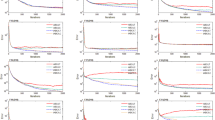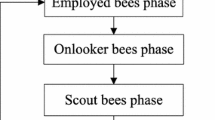Abstract
In this paper, we put forward a hybrid approach based on the life cycle for the artificial bee colony algorithm to generate dynamical varying population as well as ensure appropriate balance between exploration and exploitation. The bee life-cycle model is firstly constructed, which means that each individual can reproduce or die dynamically throughout the searching process and population size can dynamically vary during execution. With the comprehensive learning, the bees incorporate the information of global best solution into the search equation for exploration, while the Powell’s search enables the bees deeply to exploit around the promising area. Finally, we instantiate a hybrid artificial bee colony (HABC) optimizer based on the proposed model, namely HABC. Comprehensive test experiments based on the well-known CEC 2014 benchmarks have been carried out to compare the performance of HABC against other bio-mimetic algorithms. Our numerical results prove the effectiveness of the proposed hybridization scheme and demonstrate the performance superiority of the proposed algorithm.







Similar content being viewed by others
Explore related subjects
Discover the latest articles and news from researchers in related subjects, suggested using machine learning.References
Kennedy J, Eberhart RC (1995) Particle swarm optimization. In: Proceedings of the 1995 IEEE international conference on neural networks, vol 4, pp 1942–1948
Dorigo M, Gambardella LM (1997) Ant colony system: a cooperating learning approach to the travelling salesman problem. IEEE Trans Evol Comput 1(1):53–66
Passino KM (2002) Biomimicry of bacterial foraging for distributed optimization and control. IEEE Control Syst Mag 22:52–67
Clerc M, Kennedy J (2002) The particle swarm-explosion, stability, and convergence in a multidimensional complex space. IEEE Trans Evol Comput 6(1):58–73
Sumathi S, Hamsapriya T, Surekha P (2008) Evolutionary intelligence: an introduction to theory and applications with Matlab. Springer, Berlin
Hansen N, Ostermeier A (2001) Completely derandomized self-adaptation in evolution strategies. Evol Comput 9(2):159–195
Karaboga D (2005) An idea based on honey bee swarm for numerical optimization. Technical Report-TR06, Erciyes University, Engineering Faculty, Computer Engineering Department
Karaboga D, Basturk B (2007) A powerful and efficient algorithm for numerical function optimization: artificial bee colony (ABC) algorithm. J Glob Optim 39(3):459–471
Karaboga D, Basturk B (2007) Artificial bee colony (ABC) optimization algorithm for solving constrained optimization problems. In: Lecture notes in computer science, vol 4529, pp 789–798
Pan QK, Tasgetiren MF, Suganthan PN, Chua TJ (2011) A discrete artificial bee colony algorithm for the lot-streaming flow shop scheduling problem. Inf Sci 181:2455–2468
Karaboga D, Akay B, Ozturk C (2007) Artificial bee colony (ABC) optimization algorithm for training feed-forward neural networks. In: Modeling decisions for artificial intelligence, Springer, Berlin, pp 318–329
Karaboga D, Akay B (2009) A comparative study of artificial bee colony algorithm. Appl Math Comput 214:108–132
Biswas S, Kundu S, Das S, Vasilakos AV (2013) Information sharing in bee colony for detecting multiple niches in non-stationary environments. In: Christian B (ed) Proceeding of the fifteenth annual conference companion on genetic and evolutionary computation conference companion (GECCO 13 Companion), Amsterdam, The Netherlands. ACM, NY, USA, pp 1–2
Akbari R, Hedayatzadeh R, Ziarati K, Hassanizadeh B (2012) A multi-objective artificial bee colony algorithm. Swarm Evol Comput 2:39–52
Zhu GP, Kwong S (2010) Gbest-guided artificial bee colony algorithm for numerical function optimization. Appl Math Comput 217(7):3166–3173
Banharnsakun A, Achalakul T, Sirinaovakul B (2011) The best-so-far selection in artificial bee colony algorithm. Appl Soft Comput 11(2):2888–2901
Gao W, Liu S, Huang L (2013) A novel artificial bee colony algorithm based on modified search equation and orthogonal learning. IEEE Trans Cybern 43(3):1011–1024
Gao W, Liu S, Huang L (2013) A novel artificial bee colony algorithm with Powell’s method. Appl Soft Comput 13(9):3763–3775
Basturk B, Karaboga D (2012) A modified artificial bee colony algorithm for real-parameter optimization. Inf Sci 192:120–142
Kang F, Li JJ, Ma ZY (2011) Rosenbrock artificial bee colony algorithm for accurate global optimization of numerical functions. Inf Sci 181:3508–3531
Alatas B (2010) Chaotic bee colony algorithms for global numerical optimization. Expert Syst Appl 37:5682–5687
Coelho LS, Alotto P (2011) Gaussian artificial bee colony algorithm approach applied to Loneys solenoid benchmark problem. IEEE Trans Magn 47(5):1326–1329
Schmickl T, Crailsheim K (2007) HoPoMo: a model of honeybee intracolonial population dynamics and resource management. Ecol Model 204:219–245
Beshers SN, Huang ZY, Oonoa Y, Robinson GE (2001) Social inhibition and the regulation of temporal polyethism in honey bees. J Theor Biol 213:461–479
Huang ZY, Robinson GE (1996) Regulation of honey bee division of labor by colony age demography. Behav Ecol Sociobiol 39:147–158
Khoury DS, Myerscough MR, Barron AB (2011) A quantitative model of honeybee colony population dynamics. PLoS One 6:e18491
Oster GF, Wilson EO (1978) Caste and ecology in the social insects. Princeton University Press, Princeton, NJ
Huang ZY, Robinson GE (1992) Honeybee colony integration: worker–worker interactions mediate hormonally regulated plasticity in division of labor. Proc Natl Acad Sci USA 89:11726–11729
Jeanne RL (1986) The evolution of the organization of work in social insects. Monit Zool Ital 20:119–133
Seeley TD (1982) The adaptive significance of the age polyethism schedule in honeybee colonies. Behav Ecol Sociobiol 11:287–293
Cox MD, Myerscough MR (2003) A flexible model of foraging by a honey bee colony: the effects of individual behaviour on foraging success. J Theor Biol 223:179–197
DeGrandi-Hoffman G, Roth SA, Loper GL et al (1989) BEEPOP: a honeybee population dynamics simulation model. Ecol Model 45:133–150
Gheorghe M, Holcombe M, Kefalas P (2001) Computational models of collective foraging. BioSystems 61:133–141
Niu B, Zhu YL, He XX et al (2008) A lifecycle model for simulating bacterial evolution. Neurocomputing 72(1):142–148
Krink T, Løvbjerg M (2002) The lifecycle model: combining particle swarm optimisation, genetic algorithms and hillclimbers. In: Parallel problem solving from nature—PPSN VII. Springer, Berlin, pp 621–630
Powell MJD (1977) Restart procedures for the conjugate gradient method. Math Program 12:241–254
Ma L, Hu K, Zhu Y et al (2014) Discrete and continuous optimization based on hierarchical artificial bee colony optimizer. J Appl Math 2014:1–20
Rashedi E, Nezamabadi-pour H, Saryazdi S (2009) GSA: a gravitational search algorithm. Inf Sci 179(13):2232–2248
Liang JJ, Qin AK, Suganthan PN, Baskar S (2006) Comprehensive learning particle swarm optimizer for global optimization of multimodal functions. IEEE Trans Evol Comput 10(3):281–295
Salomon R (1996) Reevaluating genetic algorithm performance under coordinate rotation of benchmark functions. A survey of some theoretical and practical aspects of genetic algorithms. Biosystems 39:263–278
Yan X, Zhu Y, Zhang H et al (2012) An adaptive bacterial foraging optimization algorithm with lifecycle and social learning. Discrete Dyn Nat Soc 2012:1–10
Auger A, Hansen N (2005) A restart CMA evolution strategy with increasing population size. In: Evolutionary computation, 2005. The 2005 IEEE congress on IEEE, vol 2, pp 1769–1776
Chen H, Zhu Y (2008) Optimization based on symbiotic multi-species coevolution. Appl Math Comput 205(1):47–67
Potter MA, de Jong KA (2000) Cooperative coevolution: an architecture for evolving coadapted subcomponents. Evol Comput 8:1–29
Derrac J, García S, Molina D et al (2011) A practical tutorial on the use of nonparametric statistical tests as a methodology for comparing evolutionary and swarm intelligence algorithms. Swarm Evol Comput 1(1):3–18
Acknowledgments
This research is partially supported by National Natural Science Foundation of China and Grants 51205389, and 71271140; the National High Technology Research and Development Program of China (863 Program) (No. 2014AA052101-3).
Author information
Authors and Affiliations
Corresponding author
Rights and permissions
About this article
Cite this article
Ma, L., Zhu, Y., Zhang, D. et al. A hybrid approach to artificial bee colony algorithm. Neural Comput & Applic 27, 387–409 (2016). https://doi.org/10.1007/s00521-015-1851-x
Received:
Accepted:
Published:
Issue Date:
DOI: https://doi.org/10.1007/s00521-015-1851-x




